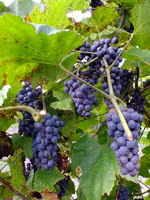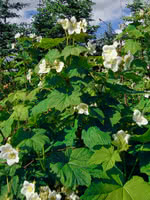Mon-Fri 9am - 5pm Mountain time
Thimbleberry vs Amur Grape
Vitis amurensis
Rubus parviflorus
NOT AVAILABLE THIS SEASON - MIGHT RETURN
NOT AVAILABLE THIS SEASON - MIGHT RETURN
The Amur Grape is an ornamental grape that fruits dark, sour, juicy grapes later in the fall. It is native to Asia, and found growing wild in Russia and China. It’s one of the most cold-hardy grape varieties, prized for its foliage that turns from a bright green to a deep crimson and purple in the fall. The flowers are small and white, usually appearing in the beginning of May.
The name for the Amur Grape comes from the Amur Valley, located in Russia. It’s extremely resistant to frost. The berries are good for fresh eating, but also make a flavorful addition to any homemade wines and preserves. The leaves are also edible, and are commonly used in salads. This plant does best with a trellis.
Note: We do not ship grape vines to BC due to regulatory restrictions from the Canadian Food Inspection Agency.
Thimbleberry is an ornamental shrub with large, green maple-like-leaves. Flowers are attractive, fragrant, and turn into red-raspberry-like berries. The berries are good for jams, cakes, breads, muffins etc. If you remove the berry, the core resembles a thimble, giving this shrub its namesake.

